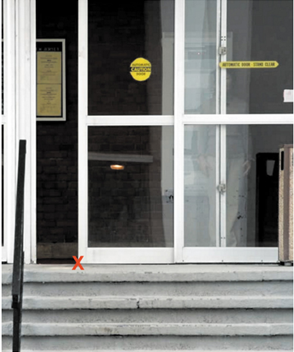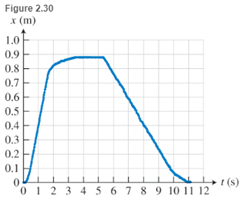
Concept explainers
Automatic sliding doors The first automatic sliding doors were described by Hero of Alexandria almost 2000 years ago. The doors were moved by hanging containers that were filled with water. Modern sliding doors open or close automatically. They are equiped with sensors that detect the proximity of a person and an electromic circuit that processes the signals from the sensors and drives the electomotor-based system that moves the doors. The sensors typically emit pulses of infrared light or ultrasound and detect the reflected pulses. By measuring the delay between emitted and received pulses, the system can determine the distance to the object from which the pulse was reflected. The whole system must be carefully designed to ensure safe and accurate functioning. Designers of such doors take into account several variables such as typical walking speeds of people and their dimensions.

Let’s try to learn more about automatic sliding doors by analyzing the motion of a single-side automatic sliding door when a person is walking through the door. Figure 2.30 shows the position-versus-time graph of the motion of the edge of the door (marked with a red cross in the photo) from the moment the door starts opening to when the door is closed while a person walks toward and through the door. The doors are adjusted to start opening when a person is 2.0 m away.

How long does it take for the door to fully open?
a. 1.5 s
b. 3 s
c. 5.5 s
d. 11 s
Want to see the full answer?
Check out a sample textbook solution
Chapter 2 Solutions
College Physics
Additional Science Textbook Solutions
Tutorials in Introductory Physics
University Physics (14th Edition)
The Cosmic Perspective
University Physics Volume 1
Essential University Physics: Volume 2 (3rd Edition)
Cosmic Perspective Fundamentals
- A hare and a tortoise compete in a race over a straight course 1.00 km long. The tortoise crawls at a speed of 0.200 m/s toward the finish line. The hare runs at a speed of 8.00 m/s toward the finish line for 0.800 km and then stops to tease the slow-moving tortoise as the tortoise eventually passes by. The hare waits for a while after the tortoise passes and then runs toward the finish line again at 8.00 m/s. Both the hare and the tortoise cross the finish line at the exact same instant. Assume both animals, when moving, move steadily at their respective speeds. (a) How far is the tortoise from the finish line when the hare resumes the race? (b) For how long in time was the hare stationary?arrow_forwardAn object is in motion when it undergoes a continuous change of ___. (2.1)arrow_forwardAn ice sled powered by a rocket engine sum from rest on a large frozen lake and accelerates at + 40 ft/s2. After some time t1, the rocket engine is shut down and the sled moves with constant velocity v for a time t2. If the total distance traveled by the sled is 17 500 ft and the total time is 90 s. find (a) the times t1 and t2 and (b) the velocity v. At the 17 500-ft mark, the sled begins to accelerate at 20 ft/s2. (c) What is the final position of the sled when it comes to rest? (d) How long does it take to come to rest?arrow_forward
- An average person sneezes about three times per day. Estimate the worldwide number of sneezes happening in a time interval approximately equal to one sneeze.arrow_forwardTwo thin rods are fastened to the inside of a circular ring as shown in Figure P2.42. One rod of length D is vertical, and the other of length L makes an angle with the horizontal. The two rods and the ring lie in a vertical plane. Two small beads are free to slide without friction along the rods. (a) If the two beads are released from rest simultaneously from the positions shown, use your intuition and guess which bead reaches the bottom first. (b) Find an expression for the time interval required for the red head to fall from point to point in terms of g and D. (c) Find an expression for the time interval required for the blue bead to slide from point to point in terms of g, L, and . (d) Show that the two time intervals found in parts (b) and (c) are equal. Hint: What is the angle between the chords of the circle and ? (e) Do these results surprise you? Was your intuitive guess in part (a) correct? This problem was inspired by an article by Thomas B. Greenslade, Jr., Galileos Paradox, Phys. Teach. 46, 294 (May 2008). Figure P2.42arrow_forwardThe electrical impulse initiated by the nerves in Linas hand, signaling she has touched a hot stove, travels to her brain as fast as 200 m/s. At this speed, estimate the travel time of this impulse.arrow_forward
- Emily challenges her husband, David, to catch a 1 bill as follows. She holds the bill vertically as in Figure P2.67, with the center of the bill between David's index finger and thumb. David must catch the bill after Emily releases it without moving his hand downward. If his reaction time is 0.2 s, will he succeed? Explain your reasoning. (This challenge is a good trick you might want to try with your friends.) Figure P2.67arrow_forwardA woman is reported to have fallen 144 ft from the 17th floor of a building, landing on a metal ventilator box that she crushed to a depth of 18.0 in. She suffered only minor injuries. Ignoring air resistance, calculate (a) the speed of the woman just before she collided with the ventilator and (b) her average acceleration while in contact with the box. (c) Modeling her acceleration as constant, calculate the time interval it took to crush the box.arrow_forwardA glider of length moves through a stationary photogate on an air track. A photogate (Fig. P2.44) is a device that measures the time interval td during which the glider blocks a beam of infrared light passing across the photogate. The ratio vd = /td is the average velocity of the glider over this part of its motion. Suppose the glider moves with constant acceleration. (a) Argue for or against the idea that vd is equal to the instantaneous velocity of the glider when it is halfway through the photogate in space. (b) Argue for or against the idea that vd is equal to the instantaneous velocity of the glider when it is halfway through the photogate in time.arrow_forward
- Towns A and B in Figure P4.64 are 80.0 km apart. A couple arranges to drive from town A and meet a couple driving from town B at the lake, L. The two couples leave simultaneously and drive for 2.50 h in the directions shown. Car 1 has a speed of 90.0 km/h. If the cars arrive simultaneously at the lake, what is the speed of car 2?arrow_forwardExplain as you solve the problem.arrow_forwardPlz answer the question in 20 minutes plz it's very urgentarrow_forward
 Principles of Physics: A Calculus-Based TextPhysicsISBN:9781133104261Author:Raymond A. Serway, John W. JewettPublisher:Cengage Learning
Principles of Physics: A Calculus-Based TextPhysicsISBN:9781133104261Author:Raymond A. Serway, John W. JewettPublisher:Cengage Learning Glencoe Physics: Principles and Problems, Student...PhysicsISBN:9780078807213Author:Paul W. ZitzewitzPublisher:Glencoe/McGraw-Hill
Glencoe Physics: Principles and Problems, Student...PhysicsISBN:9780078807213Author:Paul W. ZitzewitzPublisher:Glencoe/McGraw-Hill
 College PhysicsPhysicsISBN:9781285737027Author:Raymond A. Serway, Chris VuillePublisher:Cengage Learning
College PhysicsPhysicsISBN:9781285737027Author:Raymond A. Serway, Chris VuillePublisher:Cengage Learning Physics for Scientists and Engineers with Modern ...PhysicsISBN:9781337553292Author:Raymond A. Serway, John W. JewettPublisher:Cengage Learning
Physics for Scientists and Engineers with Modern ...PhysicsISBN:9781337553292Author:Raymond A. Serway, John W. JewettPublisher:Cengage Learning Physics for Scientists and EngineersPhysicsISBN:9781337553278Author:Raymond A. Serway, John W. JewettPublisher:Cengage Learning
Physics for Scientists and EngineersPhysicsISBN:9781337553278Author:Raymond A. Serway, John W. JewettPublisher:Cengage Learning





